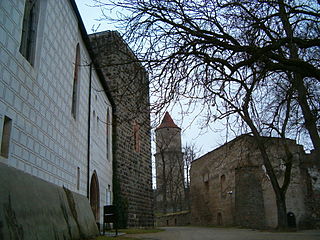Zvíkov Castle
| Zvikov Castle | ||
|---|---|---|
|
Zvíkov Castle |
||
| Alternative name (s): | Klingenberg, Zuecov | |
| Creation time : | between 1226 and 1233 | |
| Standing position : | Royal castle | |
| Place: | Zvíkovské Podhradí | |
| Geographical location | 49 ° 26 '20 " N , 14 ° 11' 31" E | |
|
|
||
The Zvíkov Castle (German Klingenberg , Latin Zuecov ) is located in the Okres Písek near Zvíkovské Podhradí in the Czech Republic at the confluence of the Vltava and Otava rivers . The surroundings of the castle complex were changed considerably with the construction of the Orlík Dam in 1960–1962.
history
On the rock spur above the confluence of the Vltava and Otava rivers, there was already a fortress, probably an oppidum, during the Celtic times .
King Přemysl Otakar I acquired the Oslover Sprengel in 1226 in exchange for six other villages from the Doksany Monastery and then had a royal castle built on the rocky spur. The castle and its burgrave Konrad von Janovice were first mentioned in writing in 1234 during the time of King Wenceslaus I. In the following period, the castle was expanded into one of the main castles of the Bohemian kings. Especially under Přemysl Ottokar II , the castle received a four-winged palace in addition to the already built tower. Defense walls and bastions followed by the end of the 13th century. The castle experienced its heyday in the time of Charles IV , who had the castle expanded and also lived in it himself. Until the completion of the new Karlstein Castle , the imperial regalia were temporarily stored on Klingenberg .
In 1429 the castle was besieged by Taborites without success . After Hussite troops besieged Klingenberg again in 1430 , King Sigismund pledged the castle and rule to the powerful Ulrich II von Rosenberg in 1431 , because he feared that his burgrave Kunata Kapléř would soon overflow to the rebels. Heinrich V von Rosenberg , who had taken over the indebted rule in 1472, sold a quarter of the properties of the House of Rosenberg on September 28, 1473 , including the Klingenberger Pfand, to his cousin Bohuslav V von Schwanberg . In 1575 Maximilian II sold the castle and rule Klingenberg hereditary to Christoph von Schwanberg auf Worlik , who connected the rule Klingenberg with Worlik. Under the Lords of Schwanberg, large parts of the goods belonging to Klingenberg Castle were slammed into Worlik Castle.
After the battle on the White Mountain , the 150 men of the Schwanberg castle garrison were able to withstand the siege by 2500 mercenaries of the imperial general Baltasar of Marradas , who camped near Jickovice and Varta, for almost two years . After the capitulation, the castle was sacked by imperial troops in the summer of 1622. The Eggenbergers received the confiscated property of Peter von Schwanberg . The castle was abandoned after 1646 and fell into disrepair. Only the farm buildings were still used.
After the outbreak of the Turkish War , the castle was restored to a state of defense in 1663. In August 1683 several neighboring noble families asked Prince Eggenberg to use the castle as a refuge because of the renewed threat from the Turks . After the male line of Eggenberg died out in 1717, the Schwarzenberg family inherited their property. In 1751, a large fire destroyed parts of the castle. With the division of the Schwarzenberg dynasty into two lines, the castle fell to the younger line in 1790. The owner Karl Philipp zu Schwarzenberg , who lived in the neighboring Worlik Castle, had the castle chapel repaired at the beginning of the 19th century and the late Gothic wall paintings secured. In 1829 the New Gate collapsed, and shortly afterwards part of the palace slid into the valley. From 1880, the princes of Schwarzenberg began restoring the royal palace and the castle walls, which continued in the 20th century. The Schwarzenberg family was expropriated in 1948 and the ruin has been state property ever since.
Building the castle
There is an arcade in the inner courtyard. A prismatic tower was built in the eastern part. From the first fortifications still a hump square tower from the erroneously as for his Steinmetz characters today are Marcomannic tower was called, and parts are given the wall. The chapel is decorated with French wall paintings from the 15th century. Overall, the building has a Gothic style with covered battlements and low defensive towers.
photos
- Views of the Zvíkov Castle
literature
- Chris Gravett: Atlas of Castles. The most beautiful castles and palaces. Tosa, Vienna 2001, ISBN 3-85492-470-4 , p. 137.





